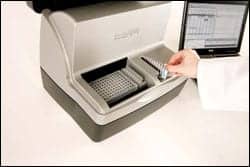The Journal of the American Medical Association (JAMA) has published results of a study of electromagnetic interference (EMI) from radio-frequency identification (RFID) technologies with medical equipment and devices in critical-care environments, which shows UHF interfered with medical devices in 63% of the tests conducted.
The study, which was conducted in a controlled environment, tested the impact of ultra-high frequency (UHF) from RFID.
The published results echo recommendations made by the Health Industry Business Communications Council (HIBCC), which in 2006 published [removed]Radio Frequency Identification in Healthcare: Benefits, Limitations, and Recommendations[/removed]. HIBCC recommended that 13.56 Mhz high frequency (HF) be adopted for health care-item-level tagging because its smaller-read range is less likely to result in EMI with medical devices.
HIBCC’s position differs from other organizations and product vendors that proposed UHF for implementation on medical-device labeling.
“Here we have additional evidence of how commercially based standards can create serious consequences if used in critical-care health care environments,” said Robert Hankin, PhD, president of HIBCC. “We applaud the recent emphasis on patient safety and other risk factors in the health-care supply chain, and we are sure the industry will take heed of studies such as this one.”
HIBCC is an industry sponsored, ANSI-accredited, standards-development organization, established by major national health care associations to develop and maintain technology standards for health care applications. The group provides standards for uniform-product identification and services for standardized-customer identification.



